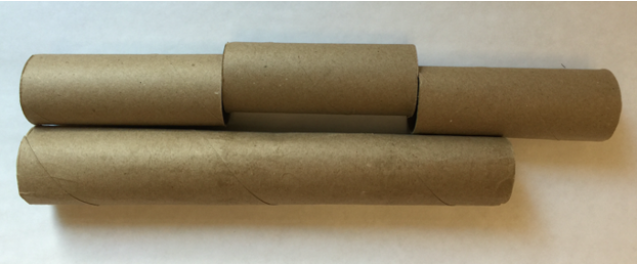24.1: Fractional Lengths
- Page ID
- 40251
Lesson
Let's solve problems about fractional lengths.
Exercise \(\PageIndex{1}\): Number Talk: Multiplication Strategies
Find the product mentally.
\(19\cdot 14\)
Exercise \(\PageIndex{2}\): Info Gap: How Many Would It Take?
Your teacher will give you either a problem card or a data card. Do not show or read your card to your partner.
If your teacher gives you the problem card:
- Silently read your card and think about what information you need to be able to answer the question.
- Ask your partner for the specific information that you need.
- Explain how you are using the information to solve the problem.
Continue to ask questions until you have enough information to solve the problem. - Share the problem card and solve the problem independently.
- Read the data card and discuss your reasoning.
If your teacher gives you the data card:
- Silently read your card.
- Ask your partner “What specific information do you need?” and wait for them to ask for information.
If your partner asks for information that is not on the card, do not do the calculations for them. Tell them you don’t have that information. - Before sharing the information, ask “Why do you need that information?” Listen to your partner’s reasoning and ask clarifying questions.
- Read the problem card and solve the problem independently.
- Share the data card and discuss your reasoning.
Are you ready for more?
Lin has a work of art that is \(14\) inches by \(20\) inches. She wants to frame it with large paper clips laid end to end.
- If each paper clip is \(1\frac{3}{4}\) inch long, how many paper clips would she need? Show your reasoning and be sure to think about potential gaps and overlaps. Consider making a sketch that shows how the paper clips could be arranged.
- How many paper clips are needed if the paper clips are spaced \(\frac{1}{4}\) inch apart? Describe the arrangement of the paper clips at the corners of the frame.
Exercise \(\PageIndex{3}\): How Many Times as Tall or as Far?
- A second-grade student is 4 feet tall. Her teacher is \(5\frac{2}{3}\) feet tall.
- How many times as tall as the student is the teacher?
- What fraction of the teacher’s height is the student’s height?
- Find each quotient. Show your reasoning and check your answer.
- \(9\div\frac{3}{5}\)
- \(1\frac{7}{8}\div\frac{3}{4}\)
- Write a division equation that can help answer each of these questions. Then find the answer. If you get stuck, consider drawing a diagram.
- A runner ran \(1\frac{4}{5}\) miles on Monday and \(6\frac{3}{10}\) miles on Tuesday. How many times her Monday’s distance was her Tuesday’s distance?
- A cyclist planned to ride \(9\frac{1}{2}\) miles but only managed to travel \(3\frac{7}{8}\) miles. What fraction of his planned trip did he travel?
Exercise \(\PageIndex{4}\): Comparing Paper Rolls
The photo shows a situation that involves fractions.

- Complete the sentences. Be prepared to explain your reasoning.
- The length of the long tube is about ______ times the length of a short tube.
- The length of a short tube is about ______ times the length of the long tube.
- If the length of the long paper roll is \(11\frac{1}{4}\) inches, what is the length of each short paper roll?
Summary
Division can help us solve comparison problems in which we find out how many times as large or as small one number is compared to another. For example, a student is playing two songs for a music recital. The first song is \(1\frac{1}{2}\) minutes long. The second song is \(3\frac{3}{4}\) minutes long.

We can ask two different comparison questions and write different multiplication and division equations to represent each question.
- How many times as long as the first song is the second song?
\(?\cdot 1\frac{1}{2}=3\frac{3}{4}\)
\(3\frac{3}{4}\div 1\frac{1}{2}=?\)
- What fraction of the second song is the first song?
\(?\cdot 3\frac{3}{4}=1\frac{1}{2}\)
\(1\frac{1}{2}\div 3\frac{3}{4}=?\)
We can use the algorithm we learned to calculate the quotients.
\(\begin{aligned} &=\frac{15}{4}\div\frac{3}{2}\\&=\frac{15}{4}\cdot\frac{2}{3}\\&=\frac{30}{12}\\&=\frac{5}{2}\end{aligned}\)
This means the second song is \(2\frac{1}{2}\) times as long as the first song.
\(\begin{aligned} &=\frac{3}{2}\div\frac{15}{4}\\&=\frac{3}{2}\cdot\frac{4}{15}\\&=\frac{12}{30}\\&=\frac{2}{5}\end{aligned}\)
This means the first song is \(\frac{2}{5}\) times as long as the second song.
Practice
Exercise \(\PageIndex{5}\)
One inch is around \(2\frac{11}{20}\) centimeters.

- How many centimeters long is 3 inches? Show your reasoning.
- What fraction of an inch is 1 centimeter? Show your reasoning.
- What question can be answered by finding \(10\div 2\frac{11}{20}\) in this situation?
Exercise \(\PageIndex{6}\)
A zookeeper is \(6\frac{1}{4}\) feet tall. A young giraffe in his care is \(9\frac{3}{8}\) feet tall.
- How many times as tall as the zookeeper is the giraffe?
- What fraction of the giraffe’s height is the zookeeper’s height?
Exercise \(\PageIndex{7}\)
A rectangular bathroom floor is covered with square tiles that are \(1\frac{1}{2}\) feet by \(1\frac{1}{2}\) feet. The length of the bathroom floor is \(10\frac{1}{2}\) feet and the width is \(6\frac{1}{2}\) feet.
- How many tiles does it take to cover the length of the floor?
- How many tiles does it take to cover the width of the floor?
Exercise \(\PageIndex{8}\)
The Food and Drug Administration (FDA) recommends a certain amount of nutrient intake per day called the “daily value.” Food labels usually show percentages of the daily values for several different nutrients—calcium, iron, vitamins, etc.
Consider the problem: In \(\frac{3}{4}\) cup of oatmeal, there is \(\frac{1}{10}\) of the recommended daily value of iron. What fraction of the daily recommended value of iron is in 1 cup of oatmeal?
Write a multiplication equation and a division equation to represent the question. Then find the answer and show your reasoning.
(From Unit 4.3.2)
Exercise \(\PageIndex{9}\)
What fraction of \(\frac{1}{2}\) is \(\frac{1}{3}\)? Draw a tape diagram to represent and answer the question. Use graph paper if needed.
(From Unit 4.2.4)
Exercise \(\PageIndex{10}\)
Noah says, “There are \(2\frac{1}{2}\) groups of \(\frac{4}{5}\) in \(2\).” Do you agree with him? Draw a tape diagram to show your reasoning. Use graph paper, if needed.
(From Unit 4.2.3)

